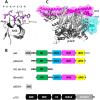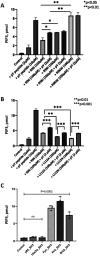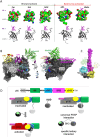This is a preprint.
Functional selection in SH3-mediated activation of the PI3 kinase
- PMID: 38746413
- PMCID: PMC11092569
- DOI: 10.1101/2024.04.30.591319
Functional selection in SH3-mediated activation of the PI3 kinase
Abstract
The phosphoinositide-3 kinase (PI3K), a heterodimeric enzyme, plays a pivotal role in cellular metabolism and survival. Its deregulation is associated with major human diseases, particularly cancer. The p85 regulatory subunit of PI3K binds to the catalytic p110 subunit via its C-terminal domains, stabilising it in an inhibited state. Certain Src homology 3 (SH3) domains can activate p110 by binding to the proline-rich (PR) 1 motif located at the N-terminus of p85. However, the mechanism by which this N-terminal interaction activates the C-terminally bound p110 remains elusive. Moreover, the intrinsically poor ligand selectivity of SH3 domains raises the question of how they can control PI3K. Combining structural, biophysical, and functional methods, we demonstrate that the answers to both these unknown issues are linked: PI3K-activating SH3 domains engage in additional "tertiary" interactions with the C-terminal domains of p85, thereby relieving their inhibition of p110. SH3 domains lacking these tertiary interactions may still bind to p85 but cannot activate PI3K. Thus, p85 uses a functional selection mechanism that precludes nonspecific activation rather than nonspecific binding. This separation of binding and activation may provide a general mechanism for how biological activities can be controlled by promiscuous protein-protein interaction domains.
Keywords: Grb2; cancer; kinase; selectivity; signalling; tertiary interactions.
Figures




Similar articles
-
Synergistic activation of a family of phosphoinositide 3-kinase via G-protein coupled and tyrosine kinase-related receptors.Chem Phys Lipids. 1999 Apr;98(1-2):79-86. doi: 10.1016/s0009-3084(99)00020-1. Chem Phys Lipids. 1999. PMID: 10358930 Review.
-
Regulation of class IA PI3Ks: is there a role for monomeric PI3K subunits?Biochem Soc Trans. 2007 Apr;35(Pt 2):199-203. doi: 10.1042/BST0350199. Biochem Soc Trans. 2007. PMID: 17371237 Review.
-
Grb2 forms an inducible protein complex with CD28 through a Src homology 3 domain-proline interaction.J Biol Chem. 1998 Aug 14;273(33):21194-202. doi: 10.1074/jbc.273.33.21194. J Biol Chem. 1998. PMID: 9694876
-
The p85 regulatory subunit controls sequential activation of phosphoinositide 3-kinase by Tyr kinases and Ras.J Biol Chem. 2002 Nov 1;277(44):41556-62. doi: 10.1074/jbc.M205893200. Epub 2002 Aug 23. J Biol Chem. 2002. PMID: 12196526
-
Quantitative analysis by surface plasmon resonance of CD28 interaction with cytoplasmic adaptor molecules Grb2, Gads and p85 PI3K.Immunol Invest. 2014;43(3):278-91. doi: 10.3109/08820139.2013.875039. Epub 2014 Jan 29. Immunol Invest. 2014. PMID: 24475931
References
-
- Aldehaiman A., Momin A.A., Restouin A., Wang L., Shi X., Aljedani S., Opi S., Lugari A., Shahul Hameed U.F., Ponchon L., Morelli X., Huang M., Dumas C., Collette Y., Arold S.T., 2021. Erratum: Synergy and allostery in ligand binding by HIV-1 Nef (Biochemical Journal 478:8 (1525–1545) DOI: 10.1042/BCJ20201002). Biochem. J. 478. 10.1042/BCJ20201002_COR - DOI - PMC - PubMed
Publication types
Grants and funding
LinkOut - more resources
Full Text Sources
Research Materials
Miscellaneous
